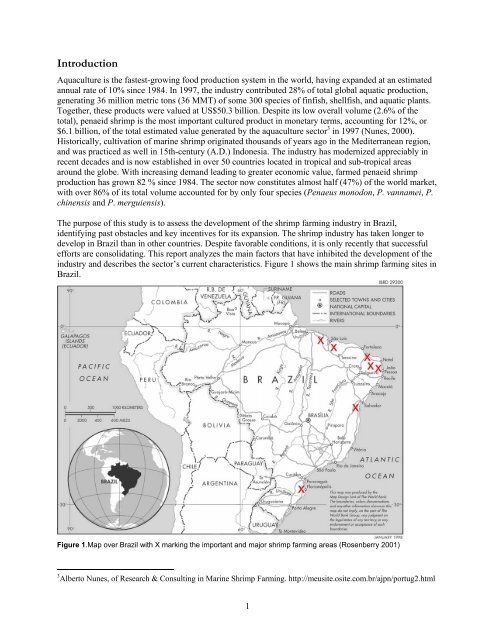Shrimp Farming in Brazil: An Industry Overview - Library - Network of ...
Shrimp Farming in Brazil: An Industry Overview - Library - Network of ...
Shrimp Farming in Brazil: An Industry Overview - Library - Network of ...
Create successful ePaper yourself
Turn your PDF publications into a flip-book with our unique Google optimized e-Paper software.
Introduction<br />
Aquaculture is the fastest-grow<strong>in</strong>g food production system <strong>in</strong> the world, hav<strong>in</strong>g expanded at an estimated<br />
annual rate <strong>of</strong> 10% s<strong>in</strong>ce 1984. In 1997, the <strong>in</strong>dustry contributed 28% <strong>of</strong> total global aquatic production,<br />
generat<strong>in</strong>g 36 million metric tons (36 MMT) <strong>of</strong> some 300 species <strong>of</strong> f<strong>in</strong>fish, shellfish, and aquatic plants.<br />
Together, these products were valued at US$50.3 billion. Despite its low overall volume (2.6% <strong>of</strong> the<br />
total), penaeid shrimp is the most important cultured product <strong>in</strong> monetary terms, account<strong>in</strong>g for 12%, or<br />
$6.1 billion, <strong>of</strong> the total estimated value generated by the aquaculture sector 3 <strong>in</strong> 1997 (Nunes, 2000).<br />
Historically, cultivation <strong>of</strong> mar<strong>in</strong>e shrimp orig<strong>in</strong>ated thousands <strong>of</strong> years ago <strong>in</strong> the Mediterranean region,<br />
and was practiced as well <strong>in</strong> 15th-century (A.D.) Indonesia. The <strong>in</strong>dustry has modernized appreciably <strong>in</strong><br />
recent decades and is now established <strong>in</strong> over 50 countries located <strong>in</strong> tropical and sub-tropical areas<br />
around the globe. With <strong>in</strong>creas<strong>in</strong>g demand lead<strong>in</strong>g to greater economic value, farmed penaeid shrimp<br />
production has grown 82 % s<strong>in</strong>ce 1984. The sector now constitutes almost half (47%) <strong>of</strong> the world market,<br />
with over 86% <strong>of</strong> its total volume accounted for by only four species (Penaeus monodon, P. vannamei, P.<br />
ch<strong>in</strong>ensis and P. merguiensis).<br />
The purpose <strong>of</strong> this study is to assess the development <strong>of</strong> the shrimp farm<strong>in</strong>g <strong>in</strong>dustry <strong>in</strong> <strong>Brazil</strong>,<br />
identify<strong>in</strong>g past obstacles and key <strong>in</strong>centives for its expansion. The shrimp <strong>in</strong>dustry has taken longer to<br />
develop <strong>in</strong> <strong>Brazil</strong> than <strong>in</strong> other countries. Despite favorable conditions, it is only recently that successful<br />
efforts are consolidat<strong>in</strong>g. This report analyzes the ma<strong>in</strong> factors that have <strong>in</strong>hibited the development <strong>of</strong> the<br />
<strong>in</strong>dustry and describes the sector’s current characteristics. Figure 1 shows the ma<strong>in</strong> shrimp farm<strong>in</strong>g sites <strong>in</strong><br />
<strong>Brazil</strong>.<br />
Figure 1.Map over <strong>Brazil</strong> with X mark<strong>in</strong>g the important and major shrimp farm<strong>in</strong>g areas (Rosenberry 2001)<br />
3 Alberto Nunes, <strong>of</strong> Research & Consult<strong>in</strong>g <strong>in</strong> Mar<strong>in</strong>e <strong>Shrimp</strong> <strong>Farm<strong>in</strong>g</strong>. http://meusite.osite.com.br/ajpn/portug2.html<br />
1

















